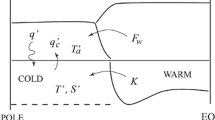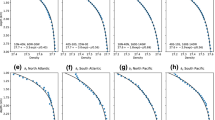Abstract
Intermittent convection and its consequences on the stability of the thermohaline circulation are investigated with an oceanic global circulation model (OGCM) and simple box models. A two-box model shows that intermittency is a consequence of the non-linearity of the equation of state and of the ratio of heat and freshwater fluxes at surface versus the fluxes at depth. Moreover, it only occurs in areas, where the instability of the water column is caused by temperature or by salinity. Intermittency is not necessarily suppressed by long restoring times. Because intermittent convection causes temporal variations of the ocean-atmosphere fluxes, an OGCM cannot reach an exact equilibrium. After a switch to mixed boundary conditions, changes of the convective activity occur in areas where intermittency is observed. Intermittent convection becomes either continuous or is stopped depending on the method used for calculating the freshwater fluxes. Advective and diffusive fluxes between these regions and their surroundings change in order to balance the altered convective fluxes. A comparison between the OGCM and a six-box model illustrates that this may lead to an alteration of adjacent deep convection and of the related deep water formation.
Similar content being viewed by others
Author information
Authors and Affiliations
Additional information
Received: 4 November 1997 / Accepted: 5 November 1998
Rights and permissions
About this article
Cite this article
Hirschi, J., Sander, J. & Stocker, T. Intermittent convection, mixed boundary conditions and the stability of the thermohaline circulation. Climate Dynamics 15, 277–291 (1999). https://doi.org/10.1007/s003820050282
Issue Date:
DOI: https://doi.org/10.1007/s003820050282




